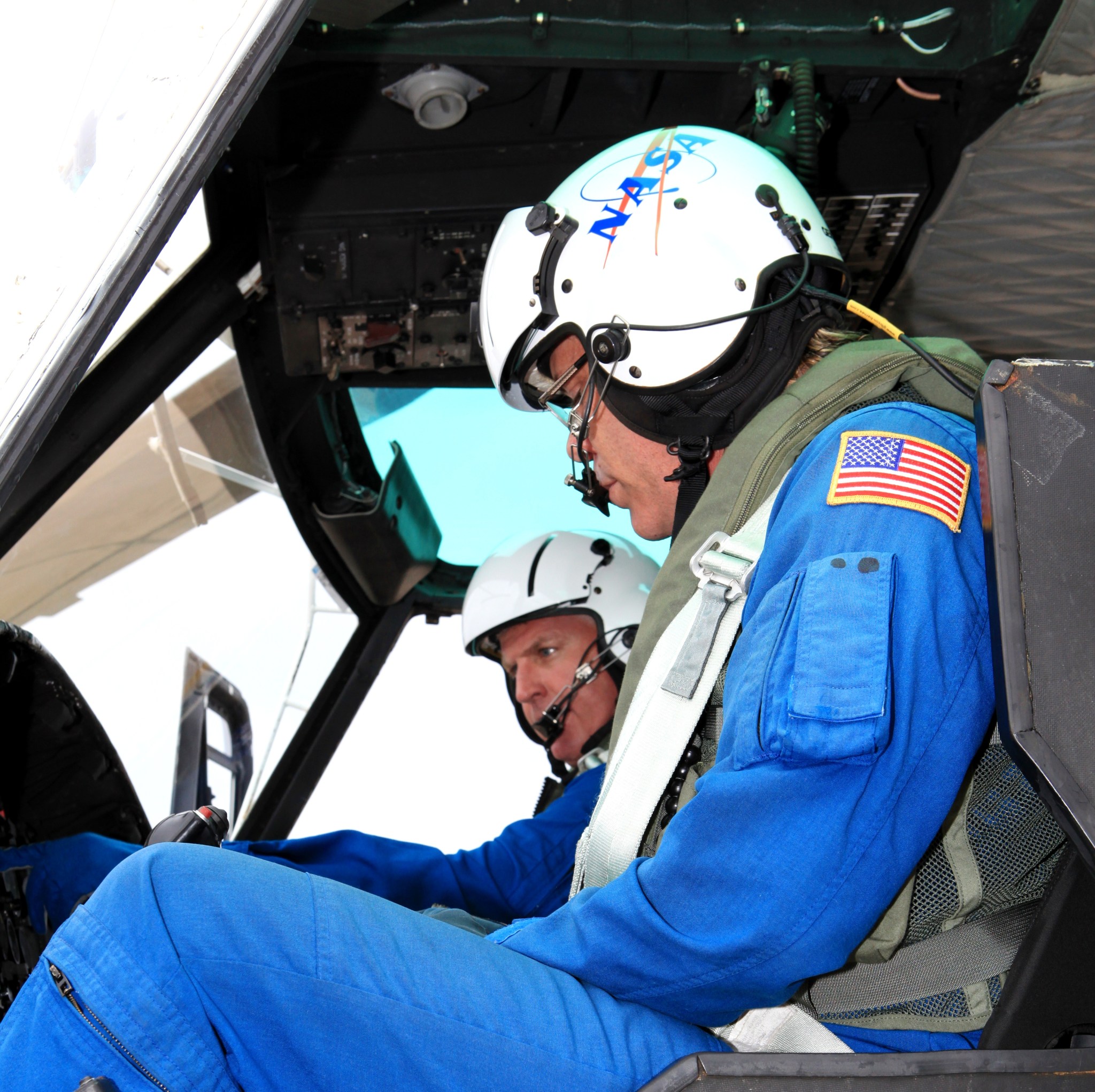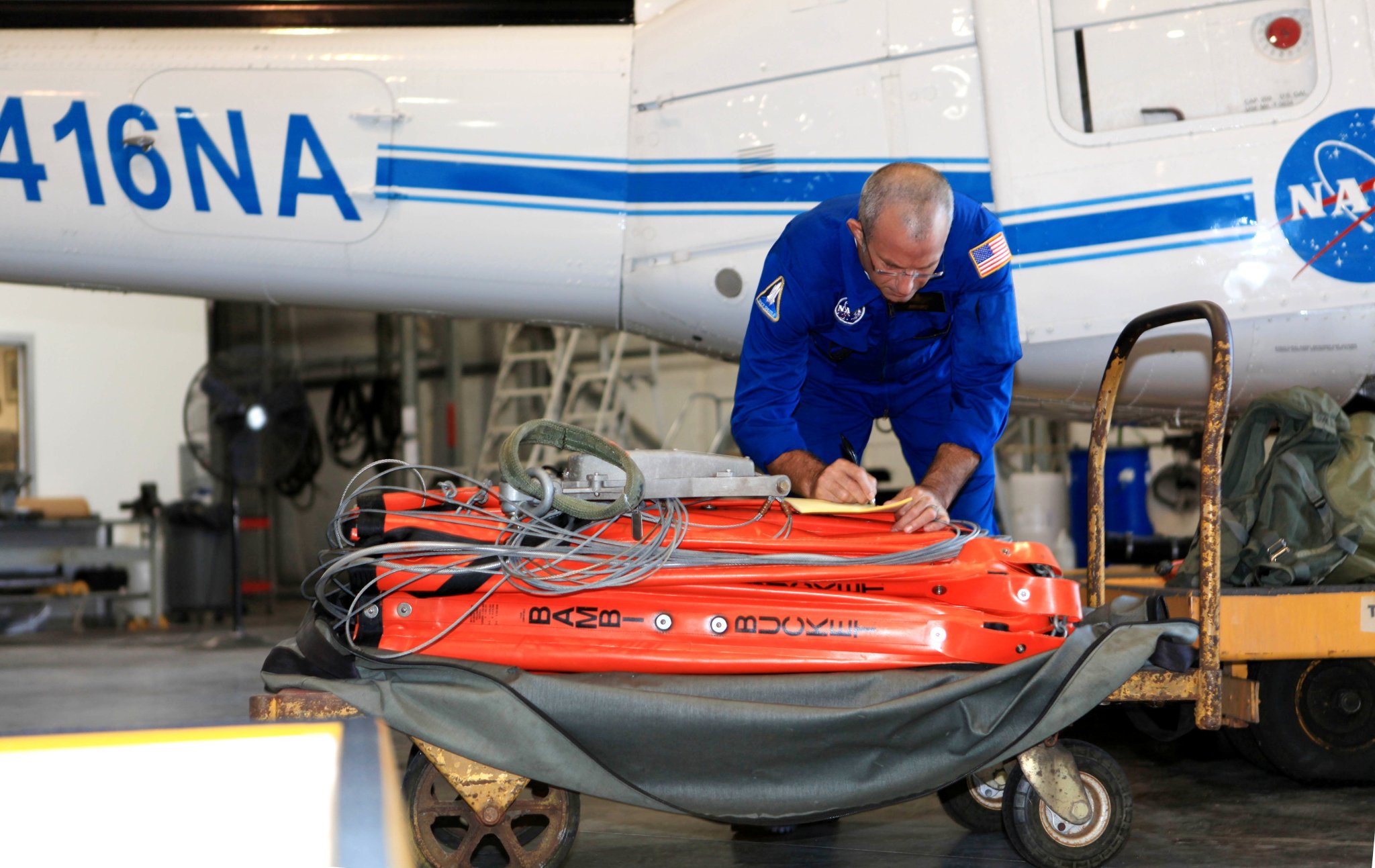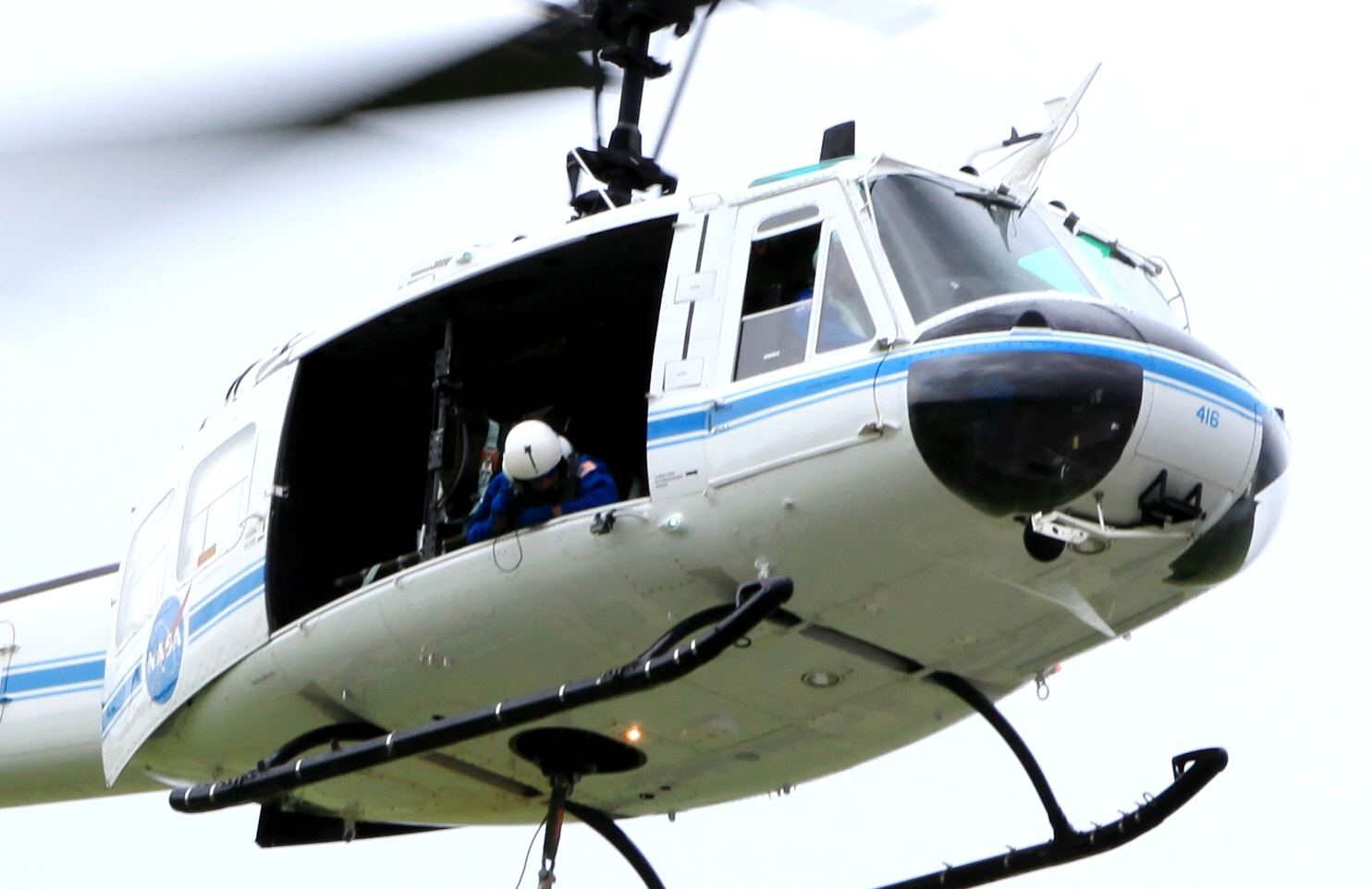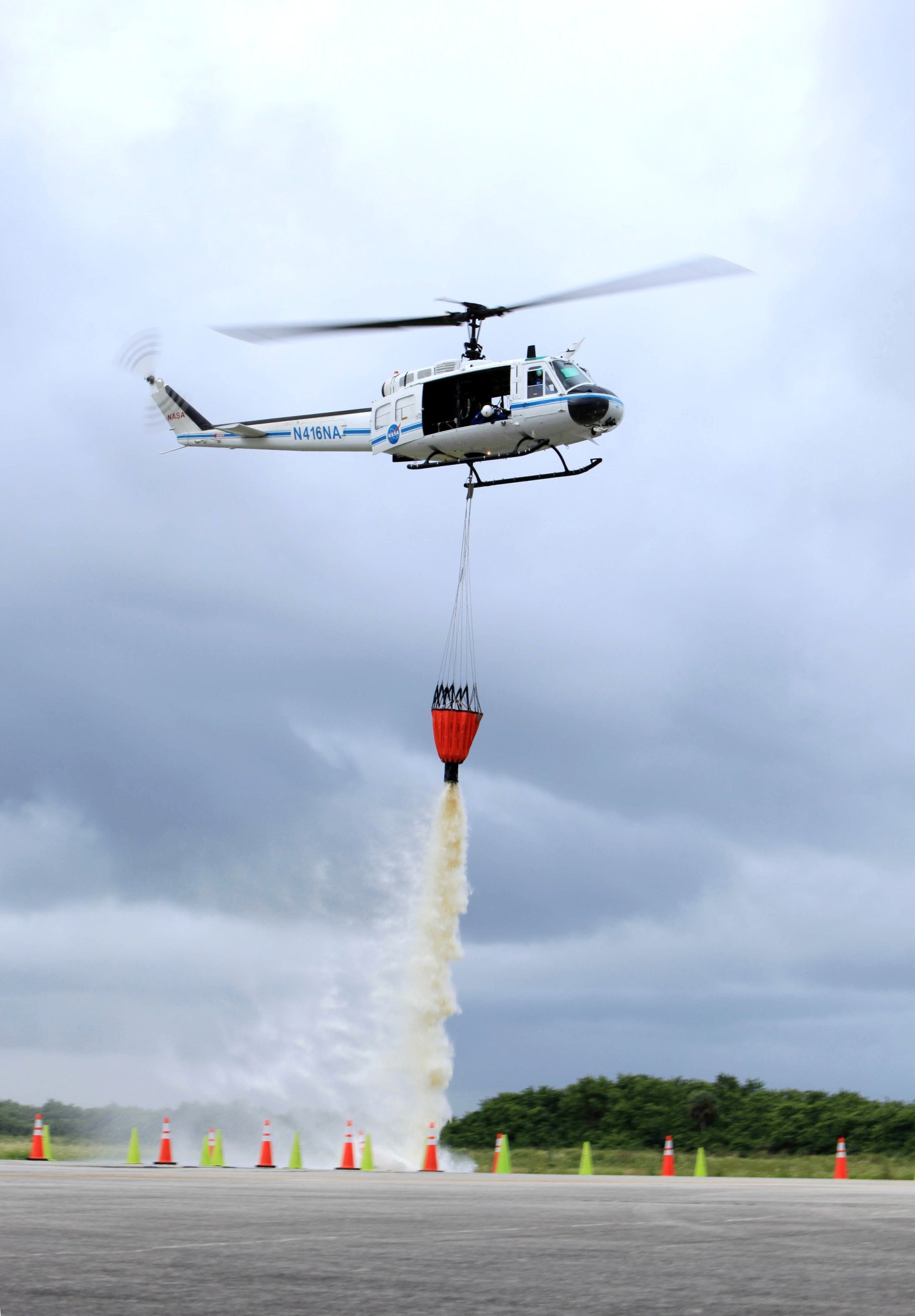Wildfires are in the news almost every day. Firefighters respond with teams on the ground and in the air. The most up-to-date tools include helicopters and aircraft that drop large quantities of water and flame retardants. This technology also is available at NASA’s Kennedy Space Center in Florida. Aircraft Operations teams are training to perfect the skills needed to ensure they are ready to use these tools in the event of an out-of-control blaze at the spaceport.
A three-person helicopter crew recently practiced picking up water from a nearby waterway and dropping it on simulated targets at the center’s Shuttle Landing Facility.
Bill Martin, a URS Federal Technical Services instructor pilot in NASA Aircraft Operations, explains that the operation includes using a device known as a “Bambi Bucket,” attached by a 23-foot cable to one of NASA’s three UH-1H “Huey” helicopters.
“Pilots can lower the bucket into one of the nearby lagoons or canals and pick up as much as 324 gallons of water,” he said. “The water can then be dropped, as needed.”
The four-foot-tall Bambi Bucket was developed in 1982 by SEI Industries Ltd. of Delta, British Columbia, in Canada. It is a collapsible bucket using a pilot-controlled valve that can deliver a concentrated column of water from the helicopter to the fire. According to the company’s website, the Bambi Bucket is now widely used by forest and land management agencies in more than 110 countries.
“The bucket is designed to help us contain a fire, not necessarily to put it out,” Martin said. “If firefighters on the ground become surrounded by flames, we can come in at low level and drop water on a specific spot to open an escape route for the people on the ground.”
When temperatures soared above 100 degrees for several days during the summer of 1998, wildfires in Central Florida forced tens of thousands of residents to evacuate and dozens of homes were destroyed. At the same time, several brush fires occurred at Kennedy. While no serious damage was done, this event showed the need for more advanced equipment for the center’s firefighters.
The Bambi Bucket was obtained in 2000 and has played a role in helping fight brush fires and ensure center safety.
On Jan. 31, 2012, a prescribed burn was taking place in the Kennedy Industrial Area. During the burn, the forecast winds changed unexpectedly, resulting in smoke and flames moving in undesired areas. NASA Flight Operations was called on to use two of the agency’s helicopters equipped with a Bambi Bucket to extinguish a fire near a building to help prevent the structure from catching fire.
Over a period of time, dried material can collect in wooded areas. Prescribed burns are conducted to reduce the amount of brush in a designated area and to minimize the likelihood of an out-of-control wildfire that could be caused by a lighting strike or other spark. The prescribed burns also are needed to protect and restore wildlife habitat.

There are several ways water can be dropped on a specific target, depending on the need.
The “wet drop” requires the helicopter crew to come in and hover, dropping water to wet down an area or a building to prevent the spread of a fire.
A “spot drop” is similar, except the crew hovers at a lower altitude, resulting in the water hitting a small area, aiming to put out the blaze in a specific location.
When spreading water in a straight line is needed, a “stitch drop” is used as the helicopter flies in a direct path over a fire.
A “hook drop” involves the helicopter flying in an arc and releasing the water in a curved pattern.
“Our training is to practice all four types of drops,” said Martin. “We want to see if any problems come up, practice drop accuracy and keep safety as our No. 1 priority.”
For the training, a crew of three flies over traffic cones set up as targets on the south end of the Shuttle Landing Facility (SLF) runway.
During the exercise on Sept. 25, Martin was the instructor pilot and Mike Tillema, Kennedy’s chief of Aircraft Operations from the Center Operations Directorate, the pilot. Crew chief Mark Smith of URS was strapped to the helicopter floor with special harnesses. Looking out the side door down at the Bambi Bucket, he informed the pilot precisely when to release the water over the target.
“Looking out the side door provides a totally different viewpoint,” Smith said. “Basically, I’m calling the shots reporting to the pilots, providing input such as obstacles that may get in the way. The pilot has his hands full flying and we want to keep everybody safe.”
For the recent training, the helicopter crew hovered over one of the canals surrounding the SLF runway and lowered the Bambi Bucket into the water.
“I give the pilots information on pulling the bucket out of the water since they can’t see it,” Smith said. “This helps him bring the bucket straight up and avoid getting it snagged.”
After ascending, the crew circled around heading south to north and flew a “stitch drop” over the line of traffic cones as targets. Splashing the row of “bull’s eyes,” the water mowed down the cones like dominoes.
So it went, one practice run after another, each time hitting the targets, perfecting their skills for a time when life or property may be at stake.
Training also involves teams on the ground. Like Martin, Kurt Giacomelli, the Aviation Safety officer with URS, wants to keep everyone focused on the center’s safety culture.

“In an emergency situation where the goal is to fight a fire, we don’t want to get caught up in the moment,” he said. “We always want to stay focused on safety for the flight crew and everyone on the ground involved in the mission.”
During a real fire emergency, Giacomelli closely manages activities with the entire team involved. This includes coordinating activities between Aircraft Operations and firefighters on the ground.
“It takes time and effort to execute the preparations and support for an air operation to go smoothly,” he said, “from tabletop review, preflight activities, mission support, mission operation and post flight.”
According to Giacomelli, the training helps everyone to become familiar with their roles and responsibilities so it will be easier in a real time emergency.
“That’s why pilots who will be flying together, train together,” he said. “Our main goal is to enhance safety while improving our process in training, support and mission success.”
After the training runs at the SLF, Tillema noted that gaining a feel for the way the Bambi Bucket system works is a key element of the training.
“All went well,” he said, “but you really feel the difference when you lift that bucket out of the water. We come straight up to avoid having the bucket swinging under us. We’re now carrying an additional 2,000 pounds and the flight characteristics change with that weight.”
Tillema had high praise for the team participating in the exercise.
“This was some of the best training I’ve witnessed,” he said. “All procedures were pre-briefed, flown and then reviewed with safety first and foremost in all of our minds. Bill Martin and Kurt Giacomelli did a great job setting this event up. This will definitely help us be ready for a real-world event.”
Being familiar with how things work and the challenges involved is why Martin believes practice is crucial.
“This training is designed to make sure we are available to provide support in a firefighting emergency,” he said. “Then we are more prepared for a dynamic situation that may occur when flying over an actual fire.”




























